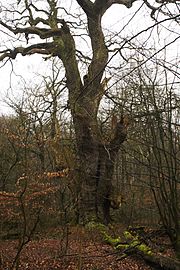Hasbruch
|
Hasbruch
|
||
|
The Hohenbökener Weg crossing the Hasbruch with autumnal foliage, October 2012 |
||
| location | West of Delmenhorst , southeast of Oldenburg | |
| surface | 630 ha | |
| Identifier | NSG WE 063 | |
| WDPA ID | 555579323 | |
| Geographical location | 53 ° 4 ′ N , 8 ° 29 ′ E | |
|
|
||
| Sea level | from 28 m to 48 m | |
| Setup date | 12/20/1997 | |
| administration | NLWKN | |
The Hasbruch is a 627 hectare oak - hornbeam forest in the district of Oldenburg in Lower Saxony , Germany , in which there are some natural monuments . The entire forest has been under nature protection since 1997 .
geography
Hasbruch - pronounced Hasbruuch, i.e. a long u and not like Armbruch, for example - is located about 20 km east of Oldenburg (Oldenburg) in the communities of Hude and Ganderkesee , on the edge of the Wildeshauser Geest . The predominant lime-rich clay soil and the high level of humidity favor the growth of common oaks , European beeches and hornbeams . Some types of softwood were introduced in the 19th century.
history
The earliest mention of the Hasbruch comes from a contract from 1258 in which the Hude monastery as owner agreed the agricultural rights of use with the surrounding farmers. At that time, the forest was significantly larger than it is today, but by the 18th century it was greatly reduced by pest cuts and sometimes illegal clearing. Agriculturally, it was also used as a hut forest until the farmers sold their rights of use piece by piece in the 19th century, most recently in 1882.

The development of the Hasbruch into a nature reserve and recreation area began around 1830 when it laid out the first walking paths. In 1889 a 16.8 hectare area of the Hasbruch was placed under nature protection, which from then on was no longer used for forestry. This area was expanded to 29 hectares in 1938. Since 1997 the entire 627 hectares of the Hasbruch are under nature protection, of which about 40 hectares are designated as natural forest , so they are not used or maintained for forestry.
The traditional Hasbruch Forestry Office was dissolved in 2005/2006 as part of the administrative reform decided by the Lower Saxony state government under Prime Minister Christian Wulff ( CDU ).
Natural monuments
Numerous very old and impressive trees, especially oaks, grow in the natural forest areas of the Hasbruch, which are overgrown like primeval forests. Some of these over 1000-year-old oaks were given their own names by the then Duke Peter Friedrich Ludwig von Oldenburg at the beginning of the nineteenth century, while other trees were popularly named. Most of these trees fell over during the twentieth century.
- The Amalia oak , presumably named after the wife of Duke Friederike Elisabeth Amalie , who died early , was considered to be the oldest and most impressive in Hasbruch at the last 1250 years. She fell over on February 10, 1982. Their remains can still be viewed today.
- The Friederike oak, also named after Friederike Elisabeth Amalie von Oldenburg, is around 1200 years old and is the oldest living oak in Hasbruch today and is considered the oldest tree in Lower Saxony. The chest height is 7.81 m (2016).
- The Charlotte oak , probably named after the mother of Duke Sophie Charlotte born. Princess of Schleswig-Holstein-Sonderburg-Beck is no longer standing.
- The Thick Oak fell victim to a fire in 1923 caused by a careless smoker.
- The song board oak collapsed in 1926 under the load of snow.
The Elise Fink Oak , which is not one of the 1000-year-old oaks, was named in 1949 after the local poet Elise Fink .
Hasbruchsingen
In 1863 choirs from Oldenburg and Bremen met for the first time to sing together at the Liedertafeleiche. The old 1200-year-old oak has died, so that the modern Hasbruchsingen, which was resumed on June 8, 1980, takes place annually in front of the hunting lodge.
Society of Friends of Hasbruch e. V.
The association was originally founded in 1964 as a citizens' initiative when the route of the federal motorway 28 through the middle of Hasbruch was planned. The hunting lodge would have become a motorway service station. A division of the Hasbruch could then be prevented.
Today the association has developed into a nature conservation association . Among other things, it promotes measures that serve to protect, maintain and maintain the Hasbruch and its surroundings as a nature reserve. The 50th anniversary of the association took place on October 25, 2014.
literature
- Lower Saxony Ministry of Food, Agriculture and Forests (ed.): Der Hasbruch. Natural history description of a north German forest . Series of publications on forest development in Lower Saxony, issue 8. Lower Saxony Forest Planning Office, Wolfenbüttel 1999
- Hans Hermann Klingenberg, Karen R. Kathe: The Hasbruch - tell old oaks . Rieck, Delmenhorst 1987, ISBN 3-920794-33-8
- Eilert Tantzen : Farewell to the historic Hasbruch Forestry Office . In: Oldenburgische Landschaft (Hrsg.): Contributions of the Oldenburgische Landschaft to the cultural history, volume 1. Focus: Forestry - Biographies - Freemasons . Isensee-Verlag, Oldenburg 2006, ISBN 3-89995-292-8
- Krimhild Stöver: The Hasbruch. Pictures and stories . Holzberg, Oldenburg 1981, ISBN 3-87358-145-0
- Wilhelm Gilly: The Hasbruch in the artistic-literary mirror of the 19th century . Ganderkesee municipal administration, Ganderkesee 1969
- Ferdinand Lindner: The Hasbruch . In: The Gazebo . Issue 26, 1880, pp. 423-427 ( full text [ Wikisource ]).
Web links
- "Hasbruch" nature reserve in the database of the Lower Saxony State Office for Water Management, Coastal and Nature Conservation (NLWKN)
- Hasbruch internet portal
- Map of the Hasbruch (PDF; 1 MB)
- Hasbruch in the culture portal Northwest




